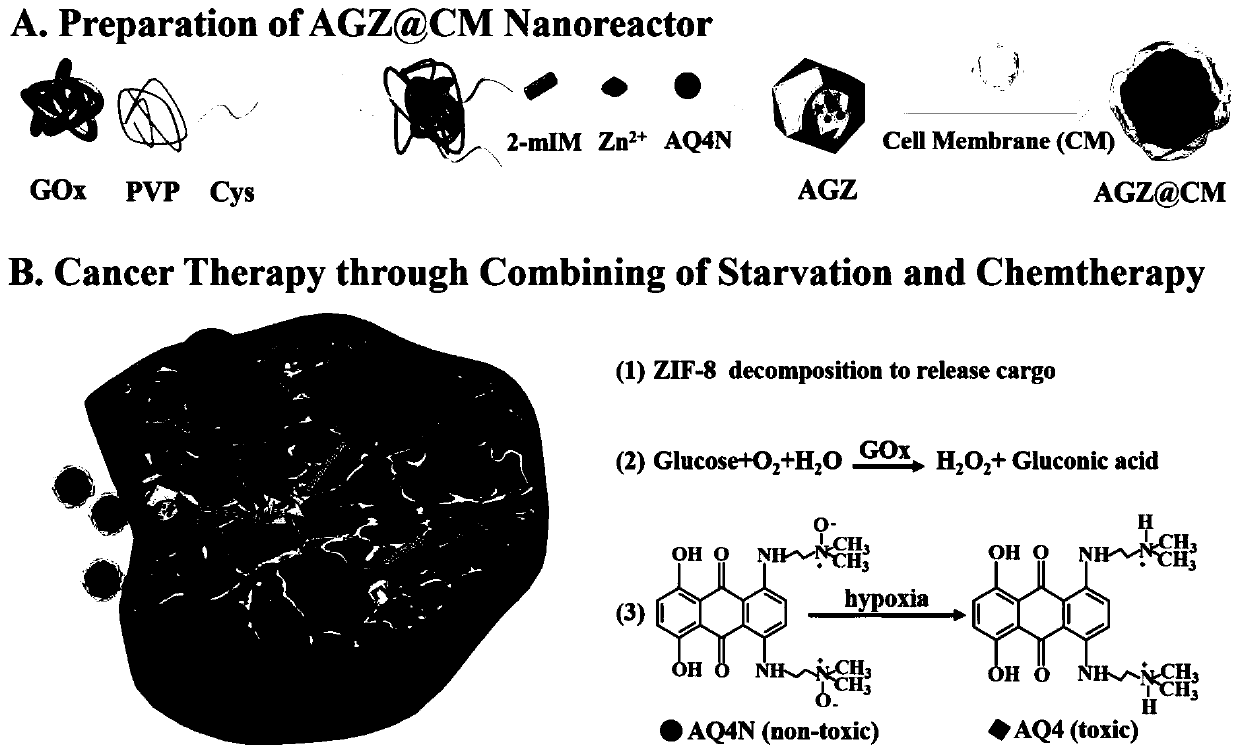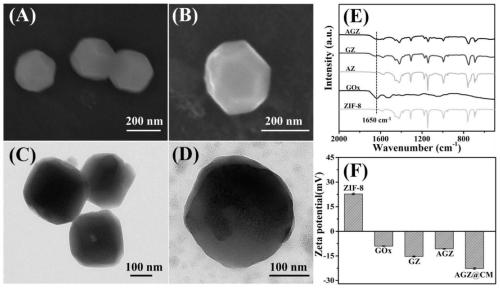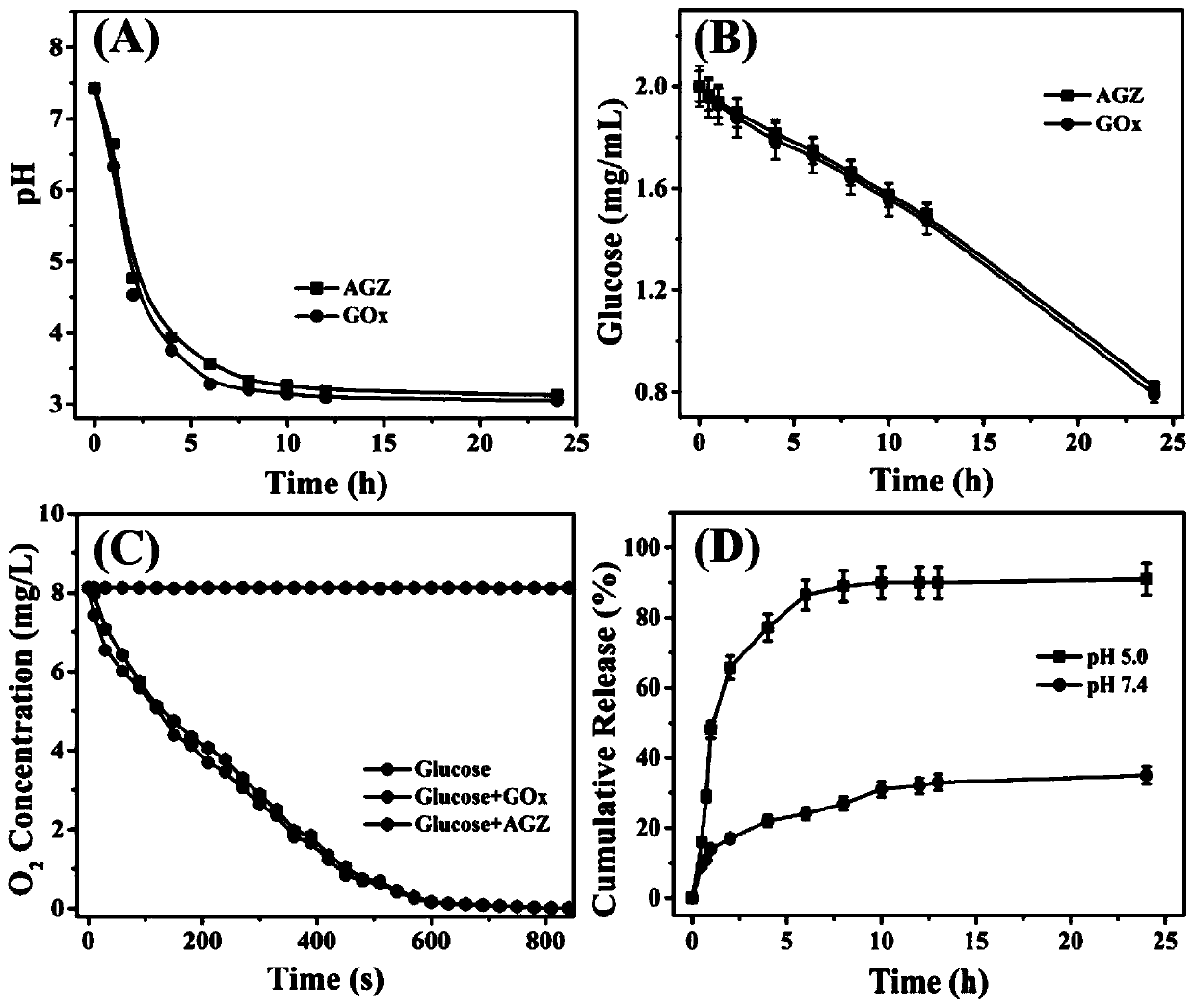Application of cancer cell membrane bionic nano-reactor AGZ@CM in preparation of anti-cancer drugs
A technology of bionic nanometer and cancer cell membrane, which is applied in the field of biomedicine, can solve the problems of loss of catalytic activity, etc., and achieve the effect of easy acquisition, simple preparation method and simple principle
- Summary
- Abstract
- Description
- Claims
- Application Information
AI Technical Summary
Problems solved by technology
Method used
Image
Examples
Embodiment 1
[0040] Example 1: Synthesis of ZIF-8 NPs
[0041] 2-mIM (160 mmol L -1 , 50 mL) and zinc acetate (40 mmol L -1 , 50 mL) were dissolved in methanol solution. Zinc acetate was added to 2-mIM with stirring at room temperature. After stirring for 12 h, the product was collected and washed 3 times with methanol. The precipitate was dried under vacuum overnight.
[0042] figure 2 A shows the SEM image of the synthesized ZIF-8 NPs, obtained from figure 2 As can be seen in A, ZIF-8 exhibits a uniform dodecahedral morphology with an average diameter of 250 nm. It indicated that ZIF-8 NPs were successfully synthesized.
Embodiment 2
[0043] Example 2: Synthesis of AZ, GZ and AGZ
[0044] First, 1 mg GOx was dissolved in 1 mL deionized water, and then 2 mg PVP (MW: 8000) was added. After stirring for 30 s, another 1 mg of Cys was introduced under stirring, and AQ4N was added to the mixed solution. Finally, 2 mL of mIM (160 mmolL -1 ) and 2 mL of zinc acetate solution (40 mmol L -1 ) and aged at room temperature for 4 h. Centrifuge, wash with water, and freeze-dry to obtain AGZ nanoparticles. AZ and GZ were synthesized in the same way, except that GOx and AQ4N were not added, respectively.
[0045] like figure 2 SEM of B and figure 2 As shown in the TEM of C, the shape and size of the GOx enzyme and prodrug AQ4N were not significantly changed after encapsulation into ZIF-8 nanoparticles, indicating that the encapsulation did not destroy the structure of ZIF-8.
Embodiment 3
[0046] Example 3: CM coated ZIF-8, AZ, GZ and AGZ nanoparticles
[0047] First, human hepatoma cell (HepG2) membranes were obtained using a membrane protein extraction kit. Briefly, cells were harvested with a cell spatula and collected by centrifugation with PBS. Thereafter, the collected cells were dispersed in membrane protein extraction buffer and PMSF. Then, the cells were quickly frozen and thawed three times in liquid nitrogen and at room temperature. The suspension was centrifuged at 4°C (700 g, 10 min) and the supernatant was further centrifuged at 4°C (14000 g, 30 min). Second, HepG2 cell membranes were mixed with nanoparticles in equal volumes and sonicated for 30 s to make the mixture homogeneous. The mixture was then continuously extruded 11 times through a 400 nm polycarbonate porous membrane using an Avanti micro-extruder (Avanti Polar Lipids). Excess membranes were discarded by centrifugation, and the final membrane-encapsulated nanoreactors were dissolved ...
PUM
 Login to View More
Login to View More Abstract
Description
Claims
Application Information
 Login to View More
Login to View More - R&D
- Intellectual Property
- Life Sciences
- Materials
- Tech Scout
- Unparalleled Data Quality
- Higher Quality Content
- 60% Fewer Hallucinations
Browse by: Latest US Patents, China's latest patents, Technical Efficacy Thesaurus, Application Domain, Technology Topic, Popular Technical Reports.
© 2025 PatSnap. All rights reserved.Legal|Privacy policy|Modern Slavery Act Transparency Statement|Sitemap|About US| Contact US: help@patsnap.com



